Conductometric H2S Sensors Based on TiO2 Nanoparticles
Abstract
:1. Introduction
2. Experimental Section
2.1. Synthesis of TiO2 Nanopowder
2.2. Characterizations
2.3. Gas Sensing Tests
3. Results and Discussion
3.1. Sample Characterizations
3.2. Gas Sensing Tests
3.3. Gas Sensing Mechanism
4. Conclusions
Author Contributions
Funding
Institutional Review Board Statement
Informed Consent Statement
Data Availability Statement
Conflicts of Interest
References
- Tong, X.; Shen, W.; Zhang, X.; Corriou, J.-P.; Xi, H. Synthesis and Density Functional Theory Study of Free-Standing Fe-Doped TiO2 Nanotube Array Film for H2S Gas Sensing Properties at Low Temperature. J. Alloys Compd. 2020, 832, 155015. [Google Scholar] [CrossRef]
- Deng, Q.; Yin, J.; Wu, X.; Zhang, T.; Wang, H.; Liu, M. Research Advances of Prevention and Control of Hydrogen Sulfide in Coal Mines. Sci. World J. 2019, 2019, e8719260. [Google Scholar] [CrossRef]
- Jameh, A.A.; Mohammadi, T.; Bakhtiari, O.; Mahdyarfar, M. Synthesis and Modification of Zeolitic Imidazolate Framework (ZIF-8) Nanoparticles as Highly Efficient Adsorbent for H2S and CO2 Removal from Natural Gas. J. Environ. Chem. Eng. 2019, 7, 103058. [Google Scholar] [CrossRef]
- Lei, Y.; Wang, K.-P.; Chen, S.; Zhang, Q.; Hu, Z.-Q. A Fluorescent Probe Based on Tetrahydro[5]Helicene for Highly Selective Recognition of Hydrogen Sulfide. Spectrochim. Acta A Mol. Biomol. Spectrosc. 2018, 204, 295–300. [Google Scholar] [CrossRef]
- Panthi, S.; Manandhar, S.; Gautam, K. Hydrogen Sulfide, Nitric Oxide, and Neurodegenerative Disorders. Transl. Neurodegener. 2018, 7, 3. [Google Scholar] [CrossRef] [PubMed]
- Tong, X.; Shen, W.; Chen, X.; Corriou, J.-P. A Fast Response and Recovery H2S Gas Sensor Based on Free-Standing TiO2 Nanotube Array Films Prepared by One-Step Anodization Method. Ceram. Int. 2017, 43, 14200–14209. [Google Scholar] [CrossRef]
- Jaballah, S.; Benamara, M.; Dahman, H.; Ly, A.; Lahem, D.; Debliquy, M.; Mir, L.E. Effect of Mg-Doping ZnO Nanoparticles on Detection of Low Ethanol Concentrations. Mater. Chem. Phys. 2020, 255, 123643. [Google Scholar] [CrossRef]
- Neri, G. First Fifty Years of Chemoresistive Gas Sensors. Chemosensors 2015, 3, 1–20. [Google Scholar] [CrossRef]
- Jaballah, S.; Benamara, M.; Dahman, H.; Lahem, D.; Debliquy, M.; El Mir, L. Formaldehyde Sensing Characteristics of Calcium-Doped Zinc Oxide Nanoparticles-Based Gas Sensor. J. Mater. Sci. Mater. Electron. 2020, 31, 8230–8239. [Google Scholar] [CrossRef]
- Kheel, H.; Sun, G.-J.; Lee, J.K.; Lee, S.; Dwivedi, R.P.; Lee, C. Enhanced H2S Sensing Performance of TiO2-Decorated α-Fe2O3 Nanorod Sensors. Ceram. Int. 2016, 42, 18597–18604. [Google Scholar] [CrossRef]
- Wu, W.; Long, J.; Guo, Y.; Zu, X.; Li, S.; Xiang, X. P-CuO/n-TiO2 Heterojunction Nanostructure-Based Surface Acoustic Wave Sensor with Strong Electric Loading Effect for Highly Sensitive H2S Gas Sensing. Sens. Actuators B Chem. 2023, 394, 134380. [Google Scholar] [CrossRef]
- Hosseini, Z.S.; Mortezaali, A.; Iraji Zad, A.; Fardindoost, S. Sensitive and Selective Room Temperature H2S Gas Sensor Based on Au Sensitized Vertical ZnO Nanorods with Flower-like Structures. J. Alloys Compd. 2015, 628, 222–229. [Google Scholar] [CrossRef]
- Lee, I.; Choi, S.-J.; Park, K.-M.; Lee, S.S.; Choi, S.; Kim, I.-D.; Park, C.O. The Stability, Sensitivity and Response Transients of ZnO, SnO2 and WO3 Sensors under Acetone, Toluene and H2S Environments. Sens. Actuators B Chem. 2014, 197, 300–307. [Google Scholar] [CrossRef]
- Dalavi, D.S.; Suryavanshi, M.J.; Patil, D.S.; Mali, S.S.; Moholkar, A.V.; Kalagi, S.S.; Vanalkar, S.A.; Kang, S.R.; Kim, J.H.; Patil, P.S. Nanoporous Nickel Oxide Thin Films and Its Improved Electrochromic Performance: Effect of Thickness. Appl. Surf. Sci. 2011, 257, 2647–2656. [Google Scholar] [CrossRef]
- Nagmani; Pravarthana, D.; Tyagi, A.; Jagadale, T.C.; Prellier, W.; Aswal, D.K. Highly Sensitive and Selective H2S Gas Sensor Based on TiO2 Thin Films. Appl. Surf. Sci. 2021, 549, 149281. [Google Scholar] [CrossRef]
- Jagadale, T.C.; Nagmani; Ramgir, N.S.; Prajapat, C.L.; Debnath, A.K.; Aswal, D.K.; Gupta, S.K. Attempts to Improve the H2S Sensitivity of TiO2 Films. AIP Conf. Proc. 2016, 1731, 080021. [Google Scholar] [CrossRef]
- Hazra, A.; Das, S.; Kanungo, J.; Sarkar, C.K.; Basu, S. Studies on a Resistive Gas Sensor Based on Sol–Gel Grown Nanocrystalline p-TiO2 Thin Film for Fast Hydrogen Detection. Sens. Actuators B Chem. 2013, 183, 87–95. [Google Scholar] [CrossRef]
- Jagadale, T.; Nagmani; Aswal, D.; Gupta, S. Exclusive H2S Detection with Greater Response Using Thermally Evaporated Titanium Oxide Film. Asian J. Mater. Chem. 2016, 1, 39–42. [Google Scholar] [CrossRef]
- Alaya, Y.; Souissi, R.; Toumi, M.; Madani, M.; Mir, L.E.; Bouguila, N.; Alaya, S. Annealing Effect on the Physical Properties of TiO2 Thin Films Deposited by Spray Pyrolysis. RSC Adv. 2023, 13, 21852–21860. [Google Scholar] [CrossRef]
- Wilson, R.L.; Simion, C.E.; Blackman, C.S.; Carmalt, C.J.; Stanoiu, A.; Di Maggio, F.; Covington, J.A. The Effect of Film Thickness on the Gas Sensing Properties of Ultra-Thin TiO2 Films Deposited by Atomic Layer Deposition. Sensors 2018, 18, 735. [Google Scholar] [CrossRef]
- Wang, X.; Cui, F.; Lin, J.; Ding, B.; Yu, J.; Al-Deyab, S.S. Functionalized Nanoporous TiO2 Fibers on Quartz Crystal Microbalance Platform for Formaldehyde Sensor. Sens. Actuators B Chem. 2012, 171–172, 658–665. [Google Scholar] [CrossRef]
- Shin, J.; Lee, G.; Choi, M.; Jang, H.; Lim, Y.; Kim, G.-S.; Nam, S.-H.; Baek, S.-H.; Song, H.-C.; Kim, J.; et al. Atomically Mixed Catalysts on a 3D Thin-Shell TiO2 for Dual-Modal Chemical Detection and Neutralization. J. Mater. Chem. A 2023, 11, 18195–18206. [Google Scholar] [CrossRef]
- Cho, D.; Suh, J.M.; Nam, S.-H.; Park, S.Y.; Park, M.; Lee, T.H.; Choi, K.S.; Lee, J.; Ahn, C.; Jang, H.W.; et al. Optically Activated 3D Thin-Shell TiO2 for Super-Sensitive Chemoresistive Responses: Toward Visible Light Activation. Adv. Sci. 2021, 8, 2001883. [Google Scholar] [CrossRef] [PubMed]
- Alaya, Y.; Chouchene, B.; Medjahdi, G.; Balan, L.; Bouguila, N.; Schneider, R. Heterostructured S-TiO2/g-C3N4 Photocatalysts with High Visible Light Photocatalytic Activity. Catalysts 2024, 14, 226. [Google Scholar] [CrossRef]
- El Mir, L.; Amlouk, A.; Barthou, C.; Alaya, S. Luminescence of Composites Based on Oxide Aerogels Incorporated in Silica Glass Host Matrix. Mater. Sci. Eng. C 2008, 28, 771–776. [Google Scholar] [CrossRef]
- El Mir, L.; Amlouk, A.; Elaloui, E.; Saadoun, M.; Pierre, A.C. Preparation and Optical Characterization of Transparent, Microporous TiO2 Xerogel Monoliths. Mater. Sci. Eng. B 2008, 146, 69–73. [Google Scholar] [CrossRef]
- Secundino-Sánchez, O.; Diaz-Reyes, J.; Sánchez-Ramírez, J.F.; Jiménez-Pérez, J.L.; Secundino-Sánchez, O.; Diaz-Reyes, J.; Sánchez-Ramírez, J.F.; Jiménez-Pérez, J.L. Structural and Optical Characterization of the Crystalline Phase Transformation of Electrospinning TiO2 Nanofibres by High Temperatures Annealing. Rev. Mex. Fís. 2019, 65, 459–467. [Google Scholar] [CrossRef]
- Ma, S.; Ye, T.; Wu, T.; Wang, Z.; Wang, Z.; Ramakrishna, S.; Vijila, C.; Wei, L. Hollow Rice Grain-Shaped TiO2 Nanostructures for High-Efficiency and Large-Area Perovskite Solar Cells. Sol. Energy Mater. Sol. Cells 2019, 191, 389–398. [Google Scholar] [CrossRef]
- Madani, M.; Omri, K.; Echabaane, M.; Gouadria, S.; Alharbi, F. Elaboration and Influence of Annealing Process on Physico-Chemical Properties of Silica–Titania Nanocomposites. Appl. Phys. A 2021, 127, 435. [Google Scholar] [CrossRef]
- Chaurasiya, N.; Singh, A.; Kumar, K.; Chandra Yadav, B.; Kumar Yadawa, P.; Kumar Singh, S.; Kumar Dey, K. A Highly Sensitive Room Temperature Liquefied Petroleum Gas (LPG) Sensor with Fast Response Based on a Titanium Dioxide (TiO2)–Reduced Graphene Oxide (r-GO) Composite. Sens. Diagn. 2023, 2, 1215–1227. [Google Scholar] [CrossRef]
- Sen, S.K.; Paul, T.C.; Dutta, S.; Matin, M.A.; Islam, M.F.; Hakim, M.A. Effect of Gamma (γ-) Irradiation on the Structural, Morphological, Optical and Electrical Properties of Spray Pyrolysis-Deposited h-MoO3 Thin Films. Surf. Interfaces 2019, 17, 100377. [Google Scholar] [CrossRef]
- Rab, N.; Chong, F.K.; Mohamed, H.I.; Lim, W.H. Preparation of TiO2 Nanoparticles by Hydrolysis of TiCl4 Using Water and Glycerol Solvent System. J. Phys. Conf. Ser. 2018, 1123, 012065. [Google Scholar] [CrossRef]
- Devanand Venkatasubbu, G.; Ramasamy, S.; Ramakrishnan, V.; Kumar, J. Folate Targeted PEGylated Titanium Dioxide Nanoparticles as a Nanocarrier for Targeted Paclitaxel Drug Delivery. Adv. Powder Technol. 2013, 24, 947–954. [Google Scholar] [CrossRef]
- Naghibi, S.; Madaah Hosseini, H.R.; Faghihi Sani, M.A.; Shokrgozar, M.A.; Mehrjoo, M. Mortality Response of Folate Receptor-Activated, PEG–Functionalized TiO2 Nanoparticles for Doxorubicin Loading with and without Ultraviolet Irradiation. Ceram. Int. 2014, 40, 5481–5488. [Google Scholar] [CrossRef]
- Sánchez-Rodríguez, D.; Méndez Medrano, M.G.; Remita, H.; Escobar-Barrios, V. Photocatalytic Properties of BiOCl-TiO2 Composites for Phenol Photodegradation. J. Environ. Chem. Eng. 2018, 6, 1601–1612. [Google Scholar] [CrossRef]
- Hoseini, S.N.; Pirzaman, A.K.; Aroon, M.A.; Pirbazari, A.E. Photocatalytic Degradation of 2,4-Dichlorophenol by Co-Doped TiO2 (Co/TiO2) Nanoparticles and Co/TiO2 Containing Mixed Matrix Membranes. J. Water Process Eng. 2017, 17, 124–134. [Google Scholar] [CrossRef]
- Hannula, M.; Ali-Löytty, K.; Lahtonen, H.; Sarlin, E.; Saari, J.; Valden, M. Improved Stability of Atomic Layer Deposited Amorphous TiO2 Photoelectrode Coatings by Thermally Induced Oxygen Defects. Chem. Mater. 2018, 30, 1199–1208. [Google Scholar] [CrossRef] [PubMed]
- Pentyala, N.; Guduru, R.K.; Shnerpunas, E.M.; Mohanty, P.S. Synthesis of Ultrafine Single Crystals and Nanostructured Coatings of Indium Oxide from Solution Precursor. Appl. Surf. Sci. 2011, 257, 6850–6857. [Google Scholar] [CrossRef]
- Al-Jumaili, B.E.; Rzaij, J.M.; Ibraheam, A.S. Nanoparticles of CuO Thin Films for Room Temperature NO2 Gas Detection: Annealing Time Effect. Mater. Today Proc. 2021, 42, 2603–2608. [Google Scholar] [CrossRef]
- Zakrzewska, K.; Radecka, M. TiO2-Based Nanomaterials for Gas Sensing—Influence of Anatase and Rutile Contributions. Nanoscale Res. Lett. 2017, 12, 89. [Google Scholar] [CrossRef]
- Huang, W.-F.; Chen, H.-T.; Lin, M.C. Density Functional Theory Study of the Adsorption and Reaction of H2S on TiO2 Rutile (110) and Anatase (101) Surfaces. J. Phys. Chem. C 2009, 113, 20411–20420. [Google Scholar] [CrossRef]
- Ji, H.; Zeng, W.; Li, Y. Gas Sensing Mechanisms of Metal Oxide Semiconductors: A Focus Review. Nanoscale 2019, 11, 22664–22684. [Google Scholar] [CrossRef]
- Xiang, C.; She, Z.; Zou, Y.; Cheng, J.; Chu, H.; Qiu, S.; Zhang, H.; Sun, L.; Xu, F. A Room-Temperature Hydrogen Sensor Based on Pd Nanoparticles Doped TiO2 Nanotubes. Ceram. Int. 2014, 40, 16343–16348. [Google Scholar] [CrossRef]
- Franke, M.E.; Koplin, T.J.; Simon, U. Metal and Metal Oxide Nanoparticles in Chemiresistors: Does the Nanoscale Matter? Small 2006, 2, 36–50. [Google Scholar] [CrossRef]
- Bai, J.; Zhou, B. Titanium Dioxide Nanomaterials for Sensor Applications. Chem. Rev. 2014, 114, 10131–10176. [Google Scholar] [CrossRef]
- Tong, X.; Shen, W.; Chen, X. Enhanced H2S Sensing Performance of Cobalt Doped Free-Standing TiO2 Nanotube Array Film and Theoretical Simulation Based on Density Functional Theory. Appl. Surf. Sci. 2019, 469, 414–422. [Google Scholar] [CrossRef]
- Ma, S.; Jia, J.; Tian, Y.; Cao, L.; Shi, S.; Li, X.; Wang, X. Improved H2S Sensing Properties of Ag/TiO2 Nanofibers. Ceram. Int. 2016, 42, 2041–2044. [Google Scholar] [CrossRef]
- Lee, A.P.; Reedy, B.J. Temperature Modulation in Semiconductor Gas Sensing. Sens. Actuators B Chem. 1999, 60, 35–42. [Google Scholar] [CrossRef]
- Arafat, M.M.; Haseeb, A.S.M.A.; Akbar, S.A.; Quadir, M.Z. In-Situ Fabricated Gas Sensors Based on One Dimensional Core-Shell TiO2-Al2O3 Nanostructures. Sens. Actuators B Chem. 2017, 238, 972–984. [Google Scholar] [CrossRef]
- Guo, W.; Feng, Q.; Tao, Y.; Zheng, L.; Han, Z.; Ma, J. Systematic Investigation on the Gas-Sensing Performance of TiO2 Nanoplate Sensors for Enhanced Detection on Toxic Gases. Mater. Res. Bull. 2016, 73, 302–307. [Google Scholar] [CrossRef]
- Shooshtari, M.; Salehi, A.; Vollebregt, S. Effect of temperature and humidity on the sensing performance of TiO2 nanowire-based ethanol vapor sensors. Nanotechnology 2021, 32, 325501. [Google Scholar] [CrossRef]
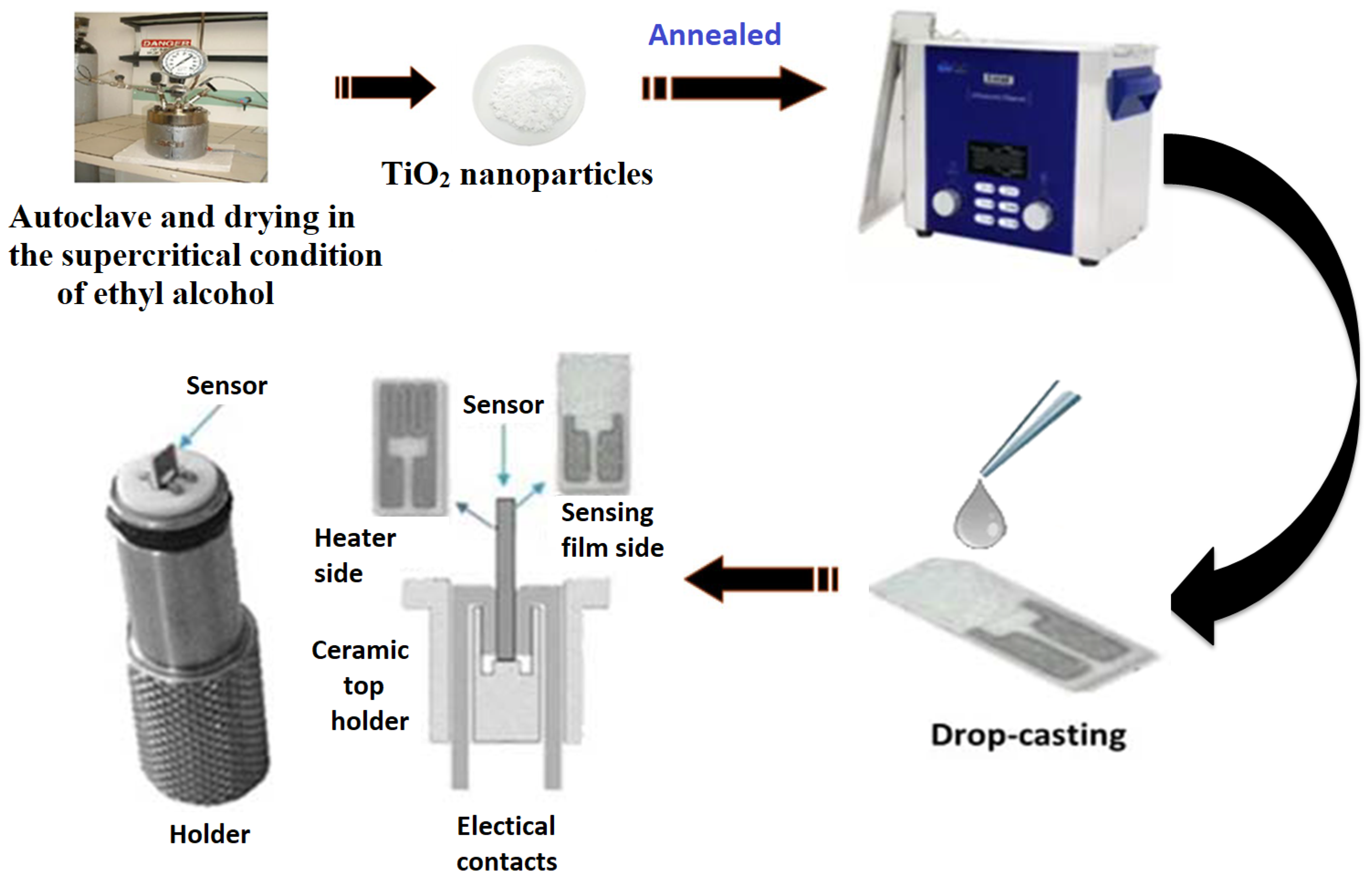
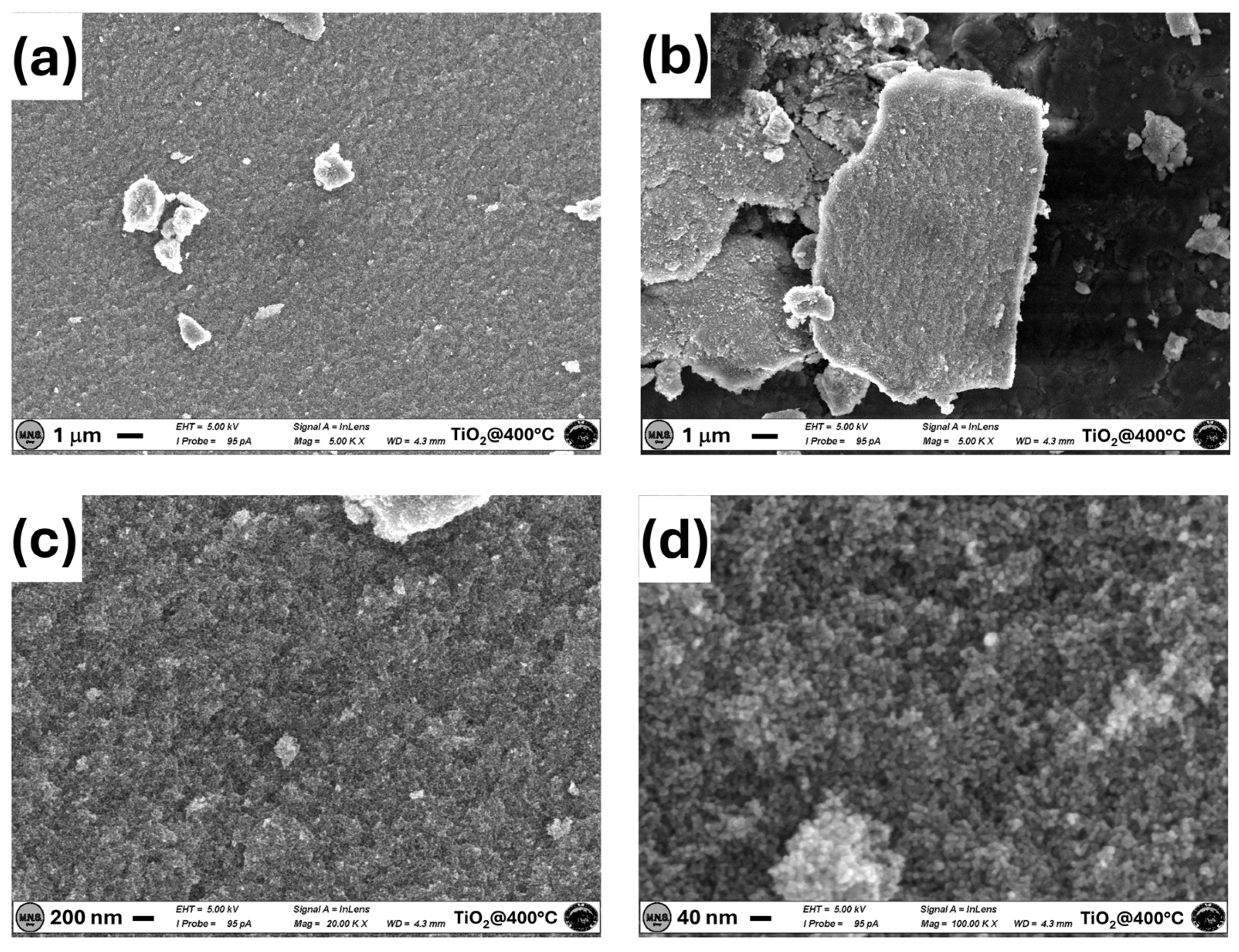




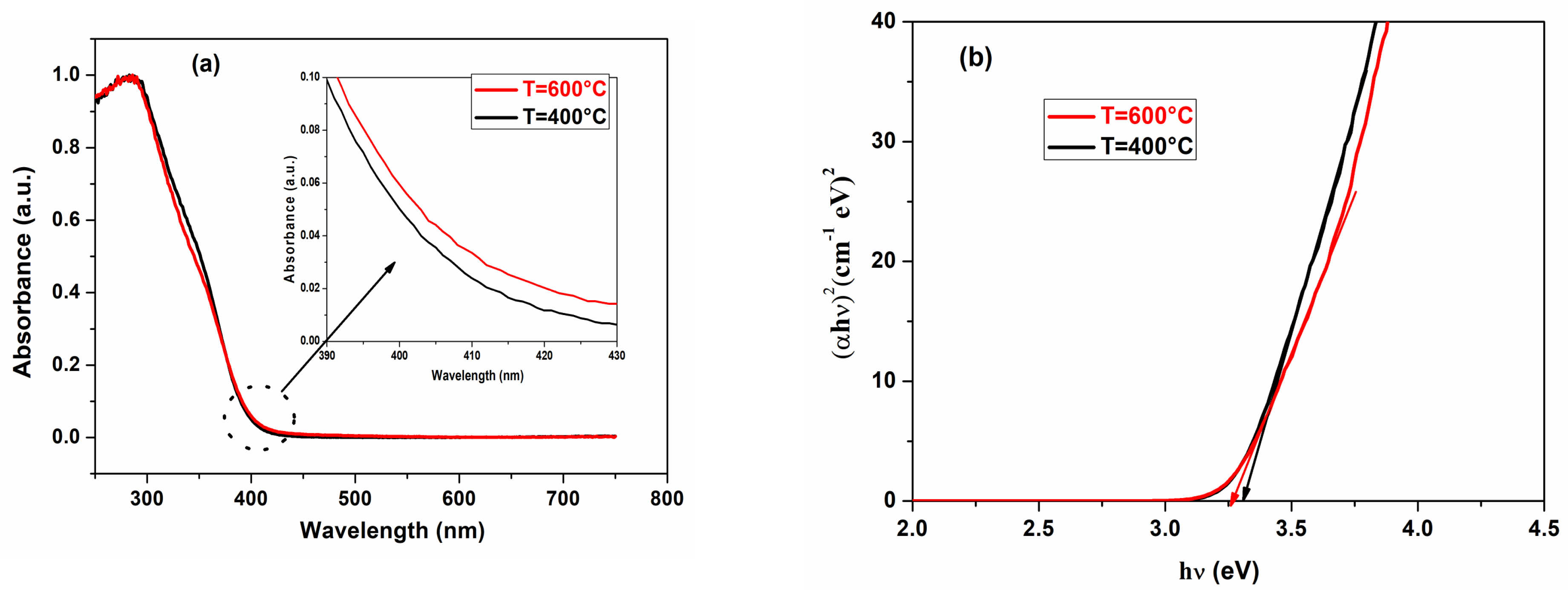

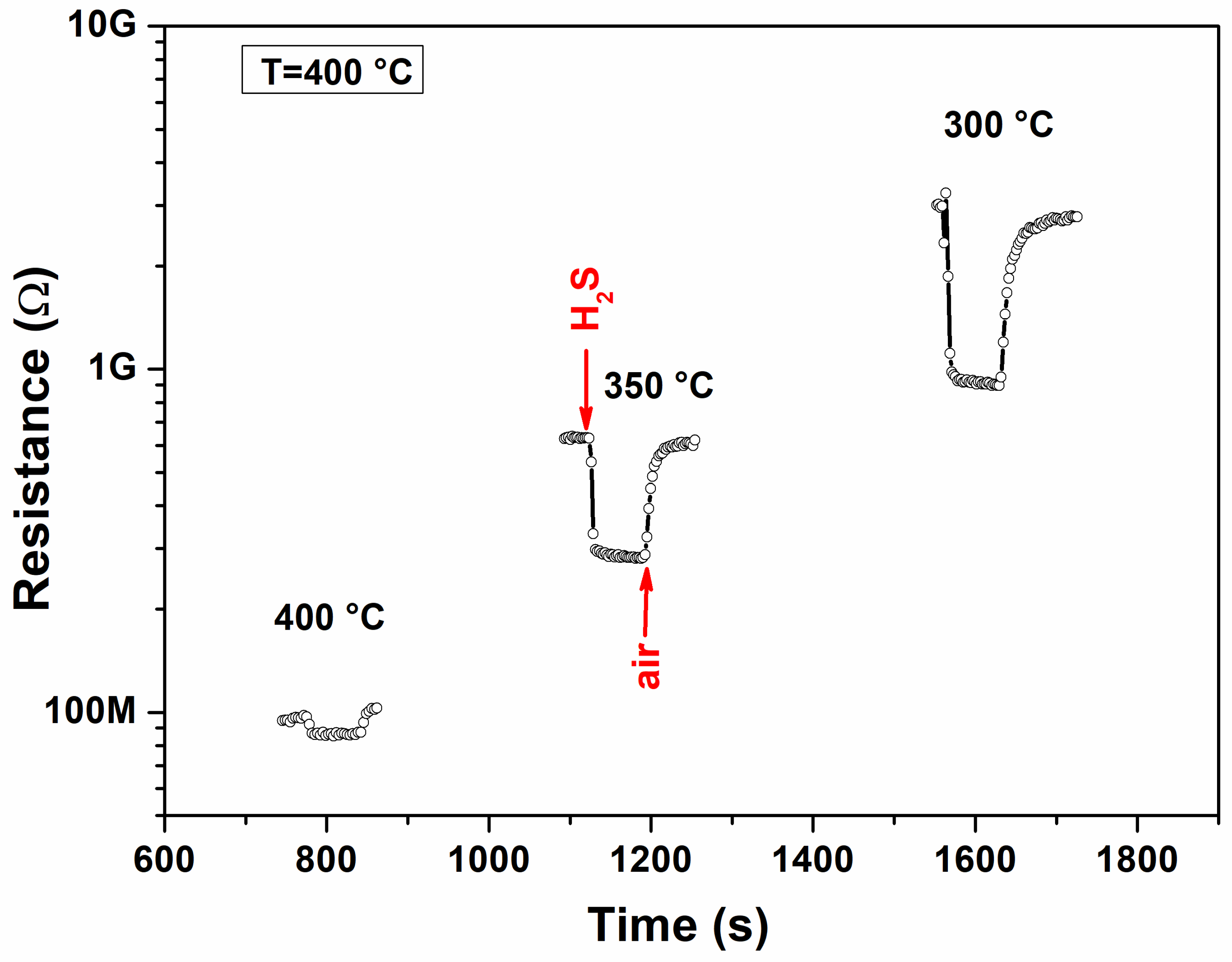
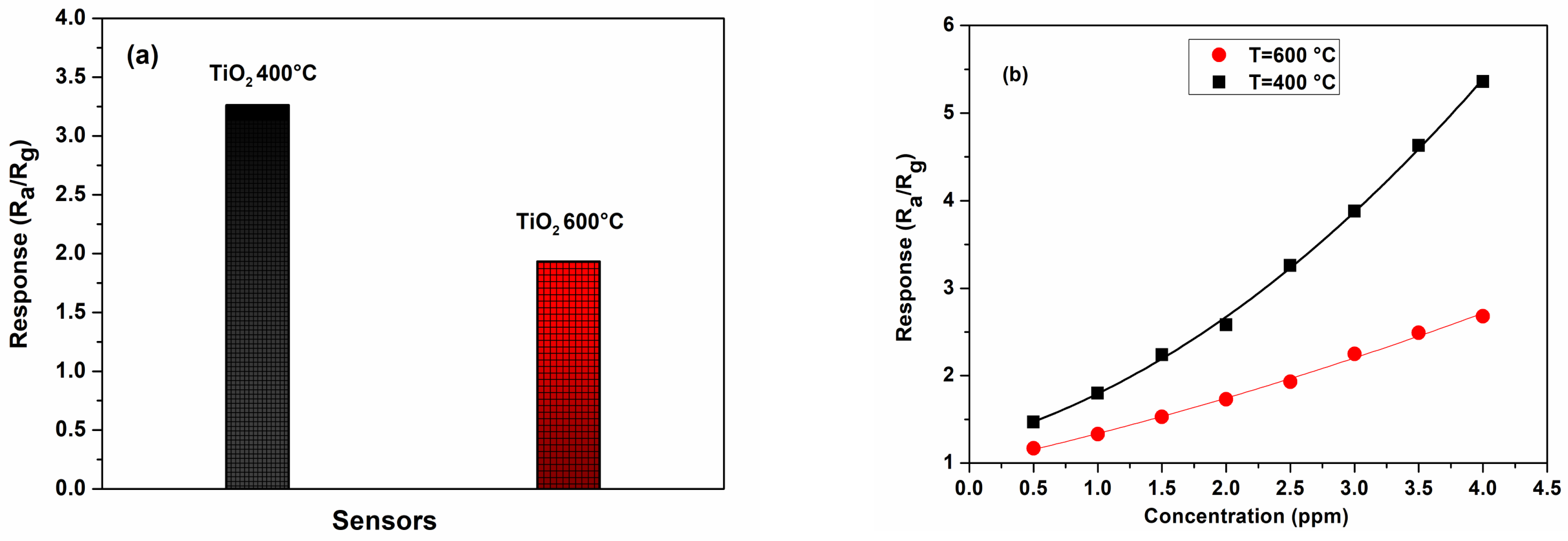

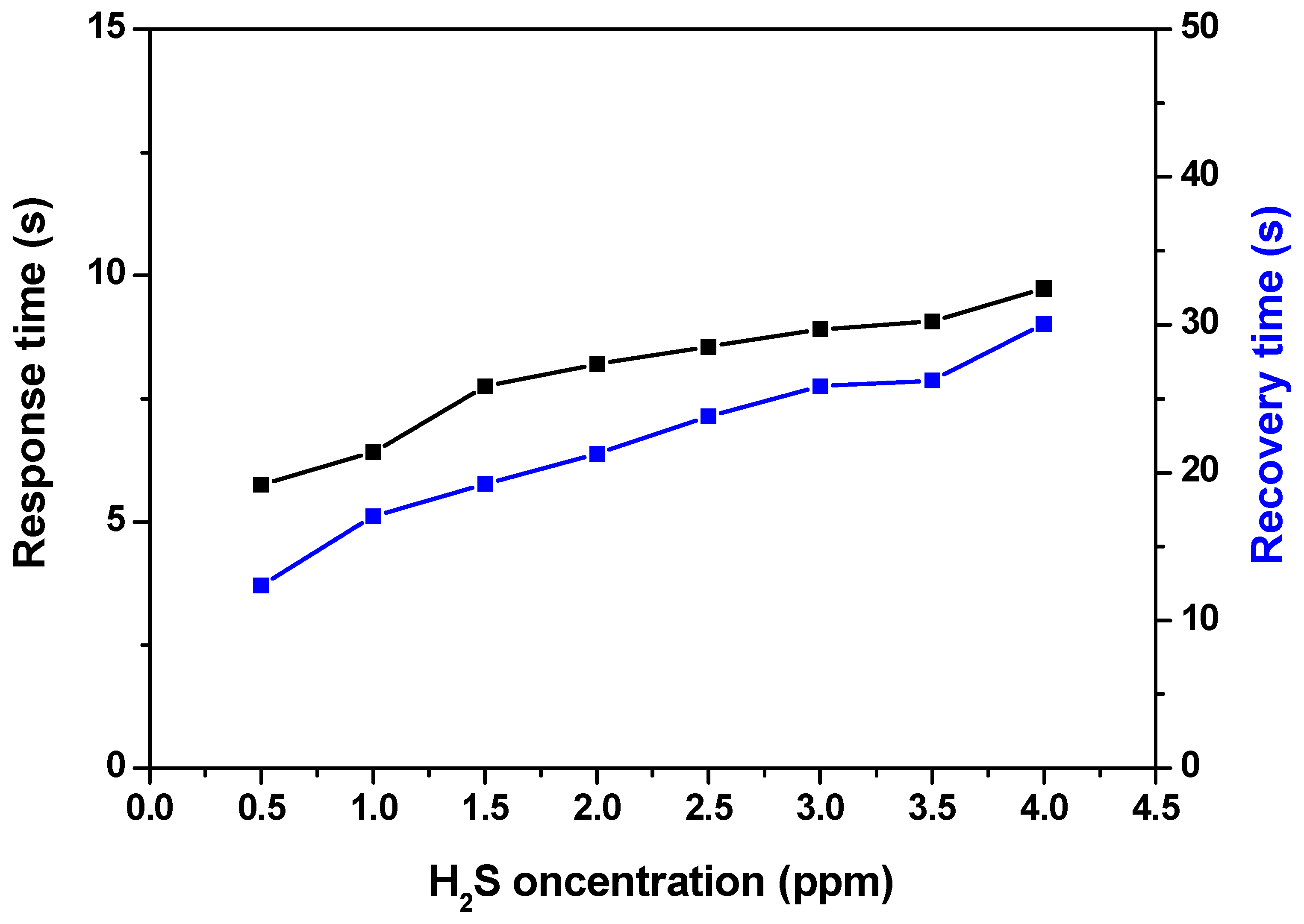

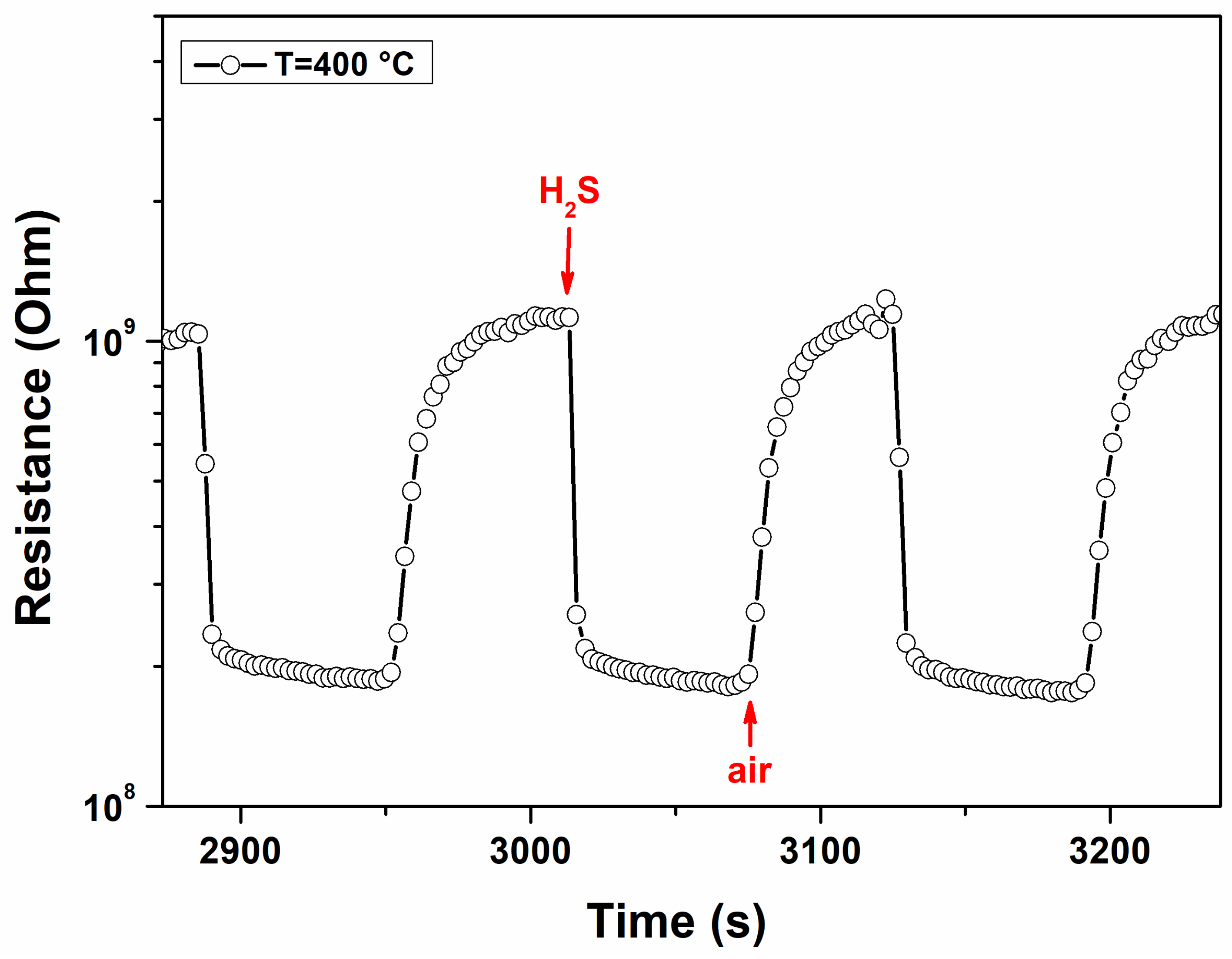

| Sample | χ2 | Bragg R-Factor | R Factors | Rp | Rwp | Rexp |
|---|---|---|---|---|---|---|
| TiO2 (400 °C) | 1.86 | 11.0 | 11.2 | 5.34 | 6.47 | 4.75 |
| TiO2 (600 °C) | 2.57 | 2.83 | 1.55 | 4.37 | 5.37 | 3.35 |
| Sample | Crystalline Phase | Space Group | Lattice Parameters (Å) | Crystallite Size (nm) | Strain (×10−5) | Phase Composition (%) |
|---|---|---|---|---|---|---|
| TiO2 (400 °C) | Tetragonal (anatase) | I41/amd | a = b = 3.7761 c = 9.4950 | 11 | 0.00359 | 100 |
| TiO2 (600 °C) | Tetragonal (anatase) | I41/amd | a = b = 3.7868 c = 9.5174 | 51 | 0.00224 | 76.95 |
| Orthorhombic (rutile) | Pnma | a = 5.1124 b = 3.2054 c = 6.0871 | - | - | 23.05 |
| Material | H2S (ppm) | Response (Ra/Rg) | Temperature (°C) | Response Time (s) | Recovery Time (s) | Reference |
|---|---|---|---|---|---|---|
| TiO2 nanoplates (Anatase) | 10 | 4.8 | 300 | 10 | - | [46] |
| TiO2 nanotube (Anatase) | 50 | 26 | 300 | 22 | 6 | [6] |
| TiO2 nanowires (Rutile) | 80 | 11 | 140 | - | - | [47] |
| TiO2-Al2O3 (Rutile) | 1000 | 38.7 | 650 | 390 | 480 | [49] |
| Ag-doped TiO2 nanofiber | 100 | 8.5 | 350 | - | - | [44] |
| CuO doped TiO2 nanoparticle (Anatase) | 50 | 1.78 | Room temperature | 14 | 22 | [50] |
| TiO2 nanoparticles (Anatase) | 2.5 | 3.3 | 350 | 8 | 23 | This work |
Disclaimer/Publisher’s Note: The statements, opinions and data contained in all publications are solely those of the individual author(s) and contributor(s) and not of MDPI and/or the editor(s). MDPI and/or the editor(s) disclaim responsibility for any injury to people or property resulting from any ideas, methods, instructions or products referred to in the content. |
© 2024 by the authors. Licensee MDPI, Basel, Switzerland. This article is an open access article distributed under the terms and conditions of the Creative Commons Attribution (CC BY) license (https://creativecommons.org/licenses/by/4.0/).
Share and Cite
Alaya, Y.; Madani, M.; Bouguila, N.; El Mir, L.; Fazio, E.; Corsaro, C.; Neri, G. Conductometric H2S Sensors Based on TiO2 Nanoparticles. Materials 2024, 17, 3283. https://doi.org/10.3390/ma17133283
Alaya Y, Madani M, Bouguila N, El Mir L, Fazio E, Corsaro C, Neri G. Conductometric H2S Sensors Based on TiO2 Nanoparticles. Materials. 2024; 17(13):3283. https://doi.org/10.3390/ma17133283
Chicago/Turabian StyleAlaya, Yassine, Malek Madani, Noureddine Bouguila, Lassaad El Mir, Enza Fazio, Carmelo Corsaro, and Giovanni Neri. 2024. "Conductometric H2S Sensors Based on TiO2 Nanoparticles" Materials 17, no. 13: 3283. https://doi.org/10.3390/ma17133283






